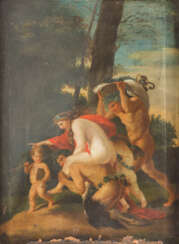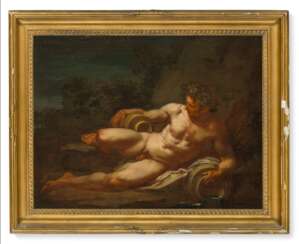никола пуссен

Nicolas Poussin, a French painter, is celebrated for establishing the French Classical tradition in art. His life's work was predominantly carried out in Rome, where he specialized in history paintings, drawing from biblical, mythological, and ancient historical narratives. These works are renowned for their narrative clarity and dramatic impact, reflecting Poussin's shift from the sensuous and colorful style of his early years to a more disciplined and rational manner influenced by classical art and the works of Raphael.
Nicolas Poussin's journey into art began in Paris around 1612, where his exposure to royal art collections and the works of Italian Renaissance artists profoundly influenced his style. His move to Rome in 1624 marked the beginning of his most impactful period, where he connected with key figures and patrons, further honing his unique style through commissions that allowed him to explore religious, mythological, and historical themes.
In Rome, Nicolas Poussin's work garnered attention and respect, culminating in his brief return to France in 1640 to become First Painter to the King. However, the challenges of the court and a preference for his life in Rome saw him return to Italy, where he continued to produce significant works like "Orion Blinded Searching for the Sun" and "The Seasons". His late works, characterized by their use of dramatic landscapes to convey human emotions, mark a departure from his earlier, more tranquil compositions.
The Metropolitan Museum of Art and the National Gallery in London house some of Poussin's most important works, offering a glimpse into the evolution of his style and the enduring impact of his art on the classical tradition.
For those interested in delving deeper into Nicolas Poussin's world and staying updated on related artworks and events, subscribing for updates is a practical step. By signing up, you'll receive curated information on new findings, sales, and auction events related to Poussin, ensuring you're well-informed about this pivotal figure in art history.


Nicolas Poussin, a French painter, is celebrated for establishing the French Classical tradition in art. His life's work was predominantly carried out in Rome, where he specialized in history paintings, drawing from biblical, mythological, and ancient historical narratives. These works are renowned for their narrative clarity and dramatic impact, reflecting Poussin's shift from the sensuous and colorful style of his early years to a more disciplined and rational manner influenced by classical art and the works of Raphael.
Nicolas Poussin's journey into art began in Paris around 1612, where his exposure to royal art collections and the works of Italian Renaissance artists profoundly influenced his style. His move to Rome in 1624 marked the beginning of his most impactful period, where he connected with key figures and patrons, further honing his unique style through commissions that allowed him to explore religious, mythological, and historical themes.
In Rome, Nicolas Poussin's work garnered attention and respect, culminating in his brief return to France in 1640 to become First Painter to the King. However, the challenges of the court and a preference for his life in Rome saw him return to Italy, where he continued to produce significant works like "Orion Blinded Searching for the Sun" and "The Seasons". His late works, characterized by their use of dramatic landscapes to convey human emotions, mark a departure from his earlier, more tranquil compositions.
The Metropolitan Museum of Art and the National Gallery in London house some of Poussin's most important works, offering a glimpse into the evolution of his style and the enduring impact of his art on the classical tradition.
For those interested in delving deeper into Nicolas Poussin's world and staying updated on related artworks and events, subscribing for updates is a practical step. By signing up, you'll receive curated information on new findings, sales, and auction events related to Poussin, ensuring you're well-informed about this pivotal figure in art history.


Nicolas Poussin, a French painter, is celebrated for establishing the French Classical tradition in art. His life's work was predominantly carried out in Rome, where he specialized in history paintings, drawing from biblical, mythological, and ancient historical narratives. These works are renowned for their narrative clarity and dramatic impact, reflecting Poussin's shift from the sensuous and colorful style of his early years to a more disciplined and rational manner influenced by classical art and the works of Raphael.
Nicolas Poussin's journey into art began in Paris around 1612, where his exposure to royal art collections and the works of Italian Renaissance artists profoundly influenced his style. His move to Rome in 1624 marked the beginning of his most impactful period, where he connected with key figures and patrons, further honing his unique style through commissions that allowed him to explore religious, mythological, and historical themes.
In Rome, Nicolas Poussin's work garnered attention and respect, culminating in his brief return to France in 1640 to become First Painter to the King. However, the challenges of the court and a preference for his life in Rome saw him return to Italy, where he continued to produce significant works like "Orion Blinded Searching for the Sun" and "The Seasons". His late works, characterized by their use of dramatic landscapes to convey human emotions, mark a departure from his earlier, more tranquil compositions.
The Metropolitan Museum of Art and the National Gallery in London house some of Poussin's most important works, offering a glimpse into the evolution of his style and the enduring impact of his art on the classical tradition.
For those interested in delving deeper into Nicolas Poussin's world and staying updated on related artworks and events, subscribing for updates is a practical step. By signing up, you'll receive curated information on new findings, sales, and auction events related to Poussin, ensuring you're well-informed about this pivotal figure in art history.


Nicolas Poussin, a French painter, is celebrated for establishing the French Classical tradition in art. His life's work was predominantly carried out in Rome, where he specialized in history paintings, drawing from biblical, mythological, and ancient historical narratives. These works are renowned for their narrative clarity and dramatic impact, reflecting Poussin's shift from the sensuous and colorful style of his early years to a more disciplined and rational manner influenced by classical art and the works of Raphael.
Nicolas Poussin's journey into art began in Paris around 1612, where his exposure to royal art collections and the works of Italian Renaissance artists profoundly influenced his style. His move to Rome in 1624 marked the beginning of his most impactful period, where he connected with key figures and patrons, further honing his unique style through commissions that allowed him to explore religious, mythological, and historical themes.
In Rome, Nicolas Poussin's work garnered attention and respect, culminating in his brief return to France in 1640 to become First Painter to the King. However, the challenges of the court and a preference for his life in Rome saw him return to Italy, where he continued to produce significant works like "Orion Blinded Searching for the Sun" and "The Seasons". His late works, characterized by their use of dramatic landscapes to convey human emotions, mark a departure from his earlier, more tranquil compositions.
The Metropolitan Museum of Art and the National Gallery in London house some of Poussin's most important works, offering a glimpse into the evolution of his style and the enduring impact of his art on the classical tradition.
For those interested in delving deeper into Nicolas Poussin's world and staying updated on related artworks and events, subscribing for updates is a practical step. By signing up, you'll receive curated information on new findings, sales, and auction events related to Poussin, ensuring you're well-informed about this pivotal figure in art history.








